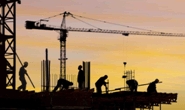Steel Markets

AGC: Construction Spending Slips in June
Written by Sandy Williams
August 2, 2019
Construction spending declined in June, but most categories made gains in the first six months of 2019 compared to the same period in 2018, says a new analysis of federal data by the Associated General Contractors of America.
Construction spending totaled $1.287 trillion at a seasonally adjusted annual rate in June, down 1.3 percent from the May rate and 2.1 percent from the June 2018 rate. Spending dipped 0.5 percent in the first six months of this year compared to the first half of 2018. Spending for the first half of the year rose for private nonresidential and public construction, but declined 7.8 percent for private residential due to weaker spending for single-family homes.
“Although the initial estimates for spending in June show decreases from May in all major categories, the first half of 2019 as a whole has been positive, aside from single-family construction,” said Ken Simonson, the association’s chief economist. “The initial monthly estimates have mostly been revised upward, making the six-month year-to-date totals a more reliable indicator of underlying trends.”
AGC’s breakdown by sector:
Public construction spending slipped 3.7 percent for the month but jumped 10.1 percent year-to-date. Spending in the first half of 2019 was up sharply for most public infrastructure, with year-to-date increases of 14.5 percent for highway and street construction spending, 7.1 percent for transportation (airports, transit, rail and port) spending, 16.2 percent for sewage and waste disposal, 15.1 percent for water supply and 12.2 percent for conservation and development.
Private nonresidential spending declined 0.3 by percent from May to June but the six-month total was 1.7 percent higher than in January-June 2018. Major private nonresidential categories experienced mixed first-half results. The largest, power construction (comprising electric power generation, transmission and distribution, plus oil and gas fields and pipelines), inched up by 0.3 percent year-to-date. Commercial (retail, warehouse and farm) construction decreased by 9.9 percent. Manufacturing construction posted an 11.6 percent gain. Private office construction spending rose 8.6 percent.
Private residential construction spending declined 0.5 percent for the month and 7.8 percent year-to-date. Single-family homebuilding decreased 7.0 percent in the first six months of the year, while spending on multifamily projects increased 11.5 percent. Spending on residential improvements plunged 13.8 percent year-to-date.
AGC cited worker shortage for declining spending between May and June as contractors struggled to find qualified workers to keep up with demand. In a survey earlier this year, 78 percent of construction firms said they are having a hard time finding enough qualified workers to hire. “As a result, the drop in construction spending in some categories in June likely reflects the fact firms are turning down or delaying projects until they have enough people on hand to do the work,” said AGC.

Sandy Williams
Read more from Sandy WilliamsLatest in Steel Markets

CMC looks beyond Arizona micro-mill woes to long-term viability of construction mart
Despite the economic and geopolitical upheaval of the last five years, CMC President and CEO Peter Matt points out that the construction market has been an essential element of the way forward.

US importers face stricter rules under revamped S232 tariffs
“CBP expects full compliance from the trade community for accurate reporting and payment of the additional duties. CBP will take enforcement action on non-compliance," the agency said in a March 7 bulletin.

Steel exports rebound in January
US steel exports recovered to a five-month high in January after having fallen to a two-year low in December. This growth follows four consecutive months of declining exports.

Construction spending drops marginally in January
Construction spending edged down slightly in January, slipping for the first time in four months. The US Census Bureau estimated spending at a seasonally adjusted annual rate of $2,196 billion in January, down 0.2% from December’s downward revised rate. The January figure is 3.3% higher than a year ago. January’s result, despite the slight erosion, […]

HVAC equipment shipments slow in December but strong annually
Shipments of heating and cooling equipment in the US fell to an 11-month low in December, according to the latest data released by the Air-Conditioning, Heating, and Refrigeration Institute (AHRI).
